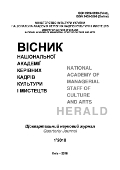МУЗЕЙ В УКРАЇНІ: АКТУАЛЬНИЙ СТАН І ПЕРСПЕКТИВИ ІНСТИТУЦІЙНОГО РОЗВИТКУ (на основі досвіду церкви)
DOI:
https://doi.org/10.32461/2226-3209.1.2018.159808Ключові слова:
музей, музейництво, інституційна ідентичність музею, церква, Ефект Лінді, криза, сарабаїти, гіроваги, кіновіти, анахотериАнотація
Мета дослідження – висвітлення актуального стану музейної інституції та перспектив її розвитку в Україні. Методологія : компаративний аналіз музею і церкви на основі "Ефекту Лінді". Наукова новизна. Вперше здійснено спеціальне наукове порівняння інститутів церкви. Дістала подальшого розвитку точка зору про те, що тенденція до екстрактивної комерціалізації, атрактизації, політизації діяльності музею не є інноваційною, оскільки маргіналізує сутність музейної роботи, що полягає у створенні репрезентацій минулого, що відображають суспільний досвід. Висновки. За "Ефектом Лінді", музеї, з високою долею імовірності, існуватимуть ще не менше, ніж три століття . За аналогіями із історії християнської церкви, було виділено групи музейників: кіновіти (справжні музейні фахівці – практики, котрі працюють для суспільства), анахорети (переважно музеєзнавці, відірвані від музейної практики та (або) один від одного), сарабаїти (мімікруючі музейники, що під прикриттям авторитету му-зею задовольняють власні матеріальні потреби, незважаючи на шкідливі для інституції наслідки) та гіроваги (як правило, молоді музейні фахівці, що хочуть бути кіновітами, проте не можуть ними бути через сарабаїтів та за-надто низьку зарплату, тому працюють у музеї або тимчасово, або неповний робочий день).
Посилання
Cameron D.F. Interview // WNYK. 1972. URL : http://www.wnyc.org/story/202241-duncan-cameron.
Cameron D.F. The museum, a temple or the forum // Curator. 1971. Volume 14. Issue 1. P. 11–24.
ICOM Code of Ethics for Museums // ICOM. URL: http://icom.museum/fileadmin/user_upload/pdf/ Codes/code_ethics2013_eng.pdf (дата звернення : 16.01.18)
Taleb N. N. How To Legally Own Another Person // Medium. URL : https://medium.com/incerto/how-to-legally-own-another-person-4145a1802bf6.
Андерсон Б. Воображаемые сообщества. Размышления об истоках и распространении национализма. М., 2016. 416 с.
Вайдахер Ф. Загальна музеологія. Львів, 2005. 630 с.
Друкер П. Ф. Энциклопедия менеджмента. М. СПб. К., 2004. 422 с.
Затворник Феофан. Устав преподобного Венедикта // Древние иноческие уставы. URL : https://azbyka.ru/otechnik/Feofan_Zatvornik/drevnie-inocheskie-ustavy.
Омельченко Ю. А. Джерела вітчизняного музейництва // Культурологічні студії. 1996. Вип. 1. С. 145–162.
Середня заробітна плата за видами економічної діяльності за місяць у 2017 році // Державна служба статистики України. URL: http://www.ukrstat.gov.ua.
Соціологія музею: презентація на тлі простору і часу / За заг. ред. В.В.Карпова. К., 2015. 167 с.
Талеб Н. Н. Антихрупкость. Как извлечь выгоду из хаоса. 2014. URL. taleb_nassim_antihrupkost_ kak_izvlech_vyigodu_iz_haosa.rtf.
Федоров Н. Ф. Музей, его смысл и назначение // Литература и жизнь. URL: http://dugward.ru/ li-brary/fedorov/fedorov_muzey.html.
Хадсон К. Влиятельные музеи. Новосибирск, 2001. 194 с.
Шола Т. Вечность здесь больше не живет. Толковый словарь музейных грехов. Тула, 2013. 357 с.
Шуберт К. Удел куратора. Концепция музея от Великой французской революции до наших дней. М.,2016. 224 с.
Anderson, B. (2016). Imagined Communities: Reflections on the Origin and Spread of Nationalism. Mos-cow [in Russian]
Cameron, D.F. (1971). The museum, a temple or the forum . Curator. Volume 14. Issue 1 [in English]
Cameron, D.F. (1972). Interview. WNYK. Retrieved from http://www.wnyc.org/story/202241-duncan-cameron/ [in English]
Druker, P. F. (2004). Encyclopedia of management. Moscow . M. Saint Petersburg. Kyiv [in Russian]
Fedorov, N. F. (1913). Museum, its meaning and purpose. Literatura i zhizn. Retrieved from http://dugward.ru/library/fedorov/fedorov_muzey.html [in Russian]
ICOM Code of Ethics for Museums (2013). Retrieved from http://icom.museum/fileadmin/ user_upload/pdf/ Codes/code_ethics2013_eng.pdf [in English]
Karpov ,V.V. (Eds.). (2015) Sociology of museum: presentation on the background of space and time. Kyiv[in Ukrainian]
Hudson, K (2001). Museums of influence. Novosibirsk [in Russian]
Omelchenko, Yu (1996). A. The sources of native museality. Kulturologіchnі studіyi. Issue. 1. [in Ukrainian]
Average salary by type of economic activity for the month in 2017 (2017). Derzhavna sluzhba statistiki Ukraїni. Retrieved from http://www.ukrstat.gov.ua/ [in Ukrainian]
Shola, T. (2013) Eternity does not live here anymore – a glossary of museum sins. Tula [in Russian]
Shubert, K. (2016) The curator's fate. The concept of the museum from the Great French Revolution to the present day. Moscow [in Russian]
Taleb, N. N (2014). Antifragile. How to gain from disorder. 2014. Retrieved from taleb_nassim_ antihrup-kost_kak_izvlech_vyigodu_iz_haosa.rtf [in Russian]
Taleb, N. N. (2016). How To Legally Own Another Person. Medium. Retrieved from https://medium.com/ incerto/how-to-legally-own-another-person-4145a1802bf6 [in English]
Vaydakher, F (2005). Common museology. Lvіv [in Ukrainian]
Zatvornik, Feofan (2018). Rules of Saint Benedict. Ancient rules of the monks. Retrieved from https://azbyka.ru/otechnik/Feofan_Zatvornik/drevnie-inocheskie-ustavy/ [in Russian]
##submission.downloads##
Опубліковано
Номер
Розділ
Ліцензія
Автори, які публікуються у цьому журналі, погоджуються з наступними умовами:
1. Автори залишають за собою право на авторство своєї роботи та передають журналу право першої публікації цієї роботи на умовах ліцензії Creative Commons Attribution License International CC-BY, котра дозволяє іншим особам вільно розповсюджувати опубліковану роботу з обов'язковим посиланням на авторів оригінальної роботи та першу публікацію роботи у цьому журналі.
2. Автори мають право укладати самостійні додаткові угоди щодо неексклюзивного розповсюдження роботи у тому вигляді, в якому вона була опублікована цим журналом (наприклад, розміщувати роботу в електронному сховищі установи або публікувати у складі монографії), за умови збереження посилання на першу публікацію роботи у цьому журналі.
3.Політика журналу дозволяє і заохочує розміщення авторами в мережі Інтернет (наприклад, у сховищах установ або на особистих веб-сайтах) рукопису роботи, як до подання цього рукопису до редакції, так і під час його редакційного опрацювання, оскільки це сприяє виникненню продуктивної наукової дискусії та позитивно позначається на оперативності та динаміці цитування опублікованої роботи.

